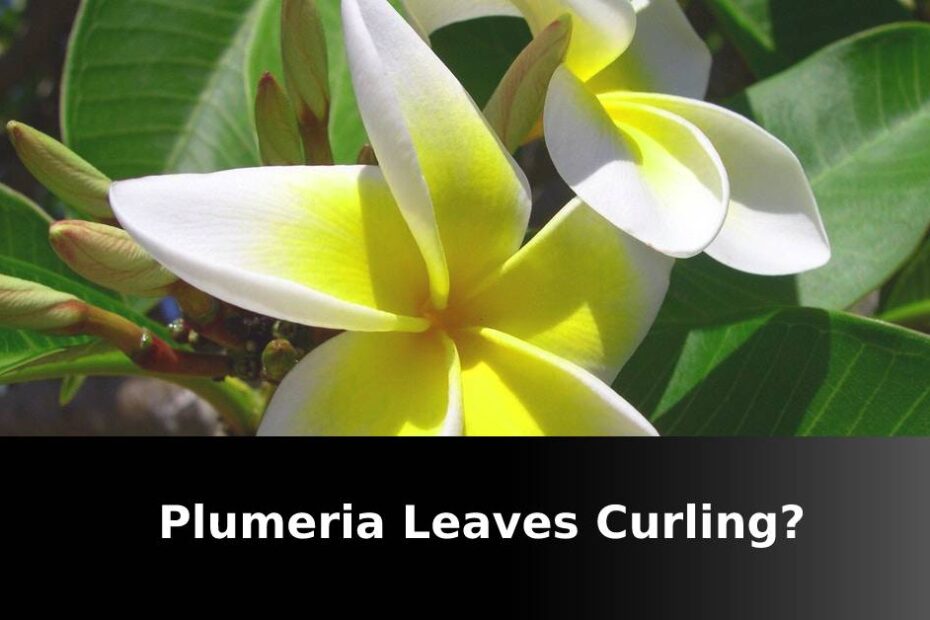While having curly Plumeria leaves isn’t really all that big of an issue, it is a sign that your plant is in need of something in particular or less of something.
Some causes for Plumeria leaves curling include improper watering, improper lighting, humidity, pests, and over fertilizing.
So with all of that said, let’s have a look at each of these issues to see which one could be causing the leaves to look a little different so you can get your Plumeria back to normal.
Improper Watering
Either overwatering or underwatering can cause curling leaves on Plumeria and other similar symptoms since the end result of either will look near the same.
By underwatering your Plumeria plant, the leaves will get dehydrated and tend to curl in response so they can try to retain any moisture possible.
If you end up overwatering your Plumeria then you will cause damage to the roots over time, making them less effective each time which can also lead to root rot.
This will in turn cause the leaves to not be able to receive water properly so the end result may look the same as if you have been underwatering.
With that said, it’s better to lean more towards underwatering as this is easier to fix compared to dealing with root rot or other overwatering issues.
Solution
Before watering your Plumeria, make sure the plant has a chance to dry out in between watering’s so you don’t run the chance of overwatering or root rot.
This can be as much as every few days in the summer or every few weeks during the cooler seasons, it just depends on how fast the soil dries up.
If the leaves have begun to wilt and you know for sure you haven’t been overwatering then you can water as soon as you notice this.
Improper Lighting
While Plumeria plants can handle lots of light, sometimes having too much direct sun or just not enough light at all can cause the leaves on your Plumeria to curl.
During the warmest months of the year, full sun may be a bit too intense for your Plumeria and in response you may begin to see the leaves curl up in response to try to retain moisture from the heat.
On the other hand, if your plant is not getting enough light on a consistent basis then the leaves may curl down or start to stretch out looking for light known as etiolation.
Solution
You really want to find that sweet spot with lighting where your plumeria still gets plenty of direct light daily, but also provide some shade during the warmer days of the year.
This can be done by growing under some shade such as trees or overhangs or if you’re growing indoors then you may want to move your plumeria a few feet away from windows to reduce the suns intensity on the plant.
Pests
There are all kinds of pests that can latch onto Plumeria’s including thrips, scales, mealybugs and spider mites.
These pests feed on the leaves sap which in turn will cause the foliage to become dehydrated and lose it’s normal appearance resulting in curled up leaves.
Some signs that you have a pest infestation on your Plumeria include the following.
- Curling leaves
- Drooping leaves
- Leaves have turned yellow
- Leaves turning white or have white spots
- Black spots on the leaves
- Stunted growth
- Holes in the foliage
- Sticky leaves
- Leaves turning brown or brown tips
Solution
Most pests can be dealt with by using rubbing alcohol and a clean towel to wipe the leaves but sometimes it may not be enough to get rid of them or keep them away.
Some pests such as scales can be harder to deal with and may require using stronger stuff such as neem oil to remove them and actually help prevent them from returning again.
I like and recommend this neem oil if you’re looking for some to use.
Also be sure to isolate your Plumeria from other plants until the pests are gone so they don’t spread between your other plants.
Humidity
Having low humidity near your Plumeria is another common cause for curling leaves as they do this in response to lack of moisture in the air and on the plant.
Humidity levels will vary depending on where you live if you’re growing strictly outdoors, but indoor growth may be easier since you can control local humidity much easier.
Solution
There’s not much you can do for humidity outdoors so for indoor growth you can try the following.
Place a water pebble tray underneath your Plumeria container since the water will evaporate and increase local humidity in the process.
Group other plants nearby to also increase local humidity and share between the others at the same time.
Use a humidifier if you have one on hand.
Over Fertilizing
Over fertilizing is another way to damage the plants roots and cause what is known as fertilizer burn which in turn will cause curled leaves and also discoloration of the plant.
I like to go a bit easier on fertilizing than most to reduce the chance of this happening as it’s always better to be safe than sorry.
While you can fertilize once a week during the active growing season, I would say you should do so every couple of weeks for best results and less chance of fertilizer burn occurring.
You also want to cut back on fertilizing much more as the year progresses as it will need less and less fertilizer towards the end of the year.
Taking it easier on the fertilizer will help prevent all of these issues but if you do end up damaging the roots then you can flush the soil out with water.
This will remove the salt that’s been built up from too much fertilizer for your Plumeria and then you can go easy moving forward.
